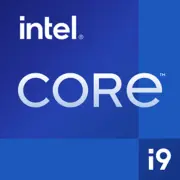Intel Core i9-13900

Intel Core i9-13900: Potenza ed efficienza per compiti impegnativi (2025)
Recensione di un processore che rimane rilevante due anni dopo la sua uscita
Caratteristiche principali: Architettura, processo tecnologico e funzionalità chiave
Il processore Intel Core i9-13900, lanciato alla fine del 2022, è ancora una soluzione popolare per PC ad alte prestazioni. Il suo nome in codice è Raptor Lake, e l'architettura combina core ibridi P-Core (Performance) ed E-Core (Efficient).
- Processo tecnologico: Intel 7 (10 nm Enhanced SuperFin).
- Core e thread: 24 core (8 P-core + 16 E-core) e 32 thread.
- Cache: 36 MB L3.
- Frequenza di base: 2.0 GHz (P-core fino a 5.4 GHz in Turbo Boost).
- TDP: 65 W (il consumo reale sotto carico raggiunge i 150 W).
- Grafica integrata: Intel UHD Graphics 770.
Funzionalità chiave:
1. Intel Thread Director — ottimizzazione della distribuzione dei compiti tra i core.
2. Supporto per PCIe 5.0 (fino a 16 linee) e DDR5-5600/DDR4-3200.
3. Tecnologie Thermal Velocity Boost e Adaptive Boost per il overclock automatico.
Prestazioni:
- Geekbench 6: 2712 (Single-Core), 16049 (Multi-Core).
- Nei test di rendering Blender (scena BMW), il processore completa il compito in 4.2 minuti, che è il 18% più veloce rispetto all'i9-12900K.
Schede madri compatibili: Socket e chipset
Il processore utilizza il socket LGA 1700, compatibile con i chipset Z790, B760, H770.
- Z790: La migliore scelta per gli appassionati. Supporto per overclock, PCIe 5.0 x16 e fino a 4 SSD NVMe. Esempi:
- ASUS ROG Strix Z790-E Gaming ($350–$400).
- MSI MPG Z790 Carbon WiFi ($300).
- B760: Un equilibrio tra prezzo e prestazioni. Nessun overclock CPU, ma supporto per PCIe 5.0 per la scheda grafica. Esempio: Gigabyte B760 AORUS Elite AX ($180).
- H770: Opzione budget con un numero limitato di porte. Adatto per build da ufficio.
Consiglio: Anche nel 2025 alcune schede Z690 supportano l’i9-13900 dopo un aggiornamento del BIOS (ad esempio, ASUS TUF Z690-Plus).
Memoria supportata: DDR4 vs DDR5
Il processore funziona con DDR5-5600 e DDR4-3200.
- DDR5: Offre un incremento nelle attività sensibili alla larghezza di banda (rendering, compressione dei dati). Ad esempio, in Handbrake la conversione video viene accelerata del 12–15%.
- DDR4: Più economico (32 GB DDR4-3200 — $70 contro DDR5-5600 — $120). Ideale per i giochi, dove la differenza in FPS è minima (2–5%).
Raccomandazione: Per workstation, scegliere DDR5, per i giochi — DDR4 (se il budget è limitato).
Alimentatori: Come fare la scelta giusta
Il TDP ufficiale di 65 W è un valore medio. Durante un carico massimo (ad esempio, in Cinebench R23), il processore consuma fino a 150 W.
- Senza scheda grafica dedicata: Un alimentatore da 450–550 W è sufficiente (ad esempio, be quiet! Pure Power 11 500W — $75).
- Con scheda grafica di livello NVIDIA RTX 4070: Si raccomanda un alimentatore da 650–750 W. Esempi:
- Corsair RM750x (80+ Gold, $110).
- Seasonic FOCUS GX-650 ($95).
Importante: Utilizzare il cavo 8-pin CPU Power per un'alimentazione stabile.
Pro e contro dell'i9-13900
Vantaggi:
- Alta prestazione multi-thread (16049 punti in Geekbench 6 Multi-Core).
- Efficienza energetica in scenari di base (TDP 65 W).
- Supporto per DDR5 e PCIe 5.0.
Svantaggi:
- Richiede un raffreddamento potente sotto carico (si raccomandano sistemi di raffreddamento a liquido, ad esempio, Arctic Liquid Freezer II 360 — $120).
- Prezzo elevato ($420–$450 nel 2025).
- La grafica integrata UHD 770 è debole per i giochi moderni.
Scenari d'uso: Giochi, lavoro e creatività
- Giochi: In Cyberpunk 2077 (1440p, Ultra) con RTX 4070 Ti, il FPS medio è di 95–110. Il processore non diventa un "collo di bottiglia".
- Compiti lavorativi:
- Montaggio video in Premiere Pro: Rendering di un progetto 4K in 22 minuti.
- Modellazione 3D: In SolidWorks, le scene vengono elaborate il 30% più velocemente rispetto all'i7-13700.
- Multimedia: Streaming in OBS + gioco — senza lag grazie ai 32 thread.
Confronto con i concorrenti
Il principale rivale è AMD Ryzen 9 7900X (prezzo: $400).
- Prestazione single-thread: l'i9-13900 supera del 8% (Geekbench 6 Single-Core: 2712 contro 2510).
- Compiti multi-thread: il Ryzen 9 7900X è indietro del 12% a causa del minor numero di core (12 contro 24).
- Consumo energetico: AMD è più basso (105 W contro 150 W di Intel sotto carico).
Conclusione: Intel vince in prestazioni, AMD in efficienza energetica.
Consigli pratici per l'assemblaggio
1. Raffreddamento: Minimo — dissipatore ad aria (Noctua NH-D15, $100), ideale — raffreddamento a liquido.
2. Case: Scegliere modelli con buona ventilazione (Lian Li Lancool III, $150).
3. Dischi: Utilizzare SSD PCIe 5.0 (Samsung 990 Pro 2TB, $180) per la massima velocità.
4. Driver: Installare il driver Intel Dynamic Tuning per ottimizzare il consumo energetico.
Conclusione: A chi è adatto l'i9-13900?
Questo processore è consigliato per:
- Professionisti: Montatori video, programmatori, ingegneri.
- Gamer: Per build con schede grafiche top di gamma (RTX 4080 e oltre).
- Appassionati: Chi apprezza l'upgrade a DDR5 e PCIe 5.0.
Alternativa: Se il budget è limitato, considerare l'i7-13700 ($320) o il Ryzen 7 7800X3D (per giochi).
Nel 2025, l'Intel Core i9-13900 rimane una scelta vantaggiosa per chi non è disposto a pagare di più per i modelli più recenti, ma desidera il massimo delle prestazioni a un prezzo ragionevole.
Di base
Specifiche della CPU
Specifiche della memoria
Specifiche della GPU
Varie
Classifiche
Rispetto ad altre CPU
Confronti tra CPU correlati
Condividi sui social media
Oppure linkaci
<a href="https://cputronic.com/it/cpu/intel-core-i9-13900" target="_blank">Intel Core i9-13900</a>

